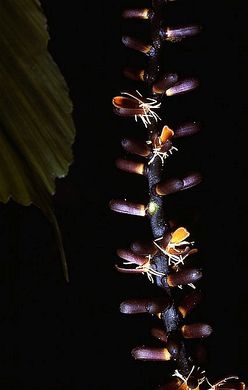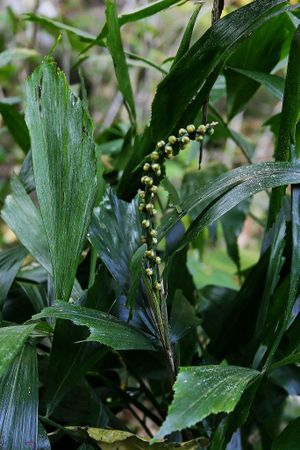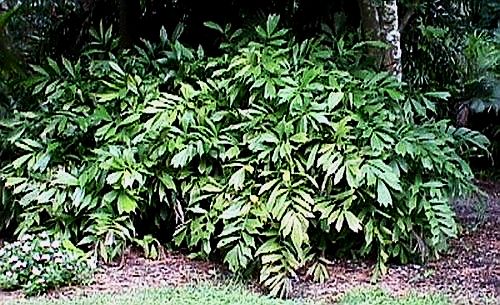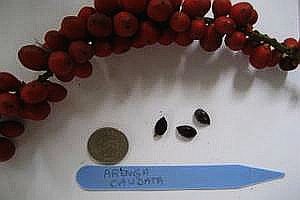Arenga caudata
| Arenga (ah-REN-gah) caudata (kaw-DAHT-ah) | |||||||
|---|---|---|---|---|---|---|---|
 Thailand. Photo by Dr. John Dransfield, Royal Botanic Gardens, Kew/Palmweb. | |||||||
| Scientific Classification | |||||||
| |||||||
| Synonyms | |||||||
|
| |||||||
| Native Continent | |||||||
|
| |||||||
| Morphology | |||||||
| |||||||
| Culture | |||||||
|
| |||||||
| Survivability index | |||||||
|
| |||||||
| Common names | |||||||
|
| |||||||
Contents
Habitat and distribution
Arenga caudata is found in Cambodia, Hainan, Laos, Malaya, South Myanmar (Burma), Thailand, and Vietnam. Lowland rain forests or deciduous forests, sometimes on limestone outcrops; below 700 m. Guangxi, Hainan [Cambodia].Description
An understory palm. Growth habit, clustering, to 1.5 m tall, 1-2 cm in diam. Leaf petioles to 0.4 m; rachis to 0.5 m; pinnae to 10 per side of rachis, linear to rhomboid (rarely blade undivided), briefly lobed along margins and with elongate apices, without ears at bases, regularly arranged and spreading in same plane except for basal few pinnae; middle pinnae to 20 cm, to 7 cm wide at mid-point. Inflorescence's to 50 cm; male rachillae 1(-3), 16-20 cm; male flowers 5-8 mm; sepals about 1 mm; petals 5-8 mm; stamens 13-15; female rachilla 1, to 30 cm; female flowers about 5 mm; sepals about 1 mm; petals 2-3 mm. Fruits red, ellipsoid to oblong, about 1.5 × 0.8 cm. Editing by edric.
Arenga caudata is an extremely variable low growing, suckering palm with dense, compact, clumping habit, 1,2-1,5 m tall and up to 2,1 m in diameter, that shows many leaf variations. The many local forms and varieties cannot satisfactorily distinguished and, perhaps, some of them should be recognized at the species level. Stems: Multistemmed up to 1,5 m tall and 1-2 cm in diameter, semelparous. Leaves: Up to 1 metre long, green to dark green on the upper surface, silver-white on the lower surface, ending in a triangular (wedge-shaped) leaflets, lateral leaflets ( pinnae) up to 10 per side of rachis (rarely blade undivided), not born on a short stalk, linear to rhomboidal without basal ear, briefly lobed along margins, with elongate praemorse apexes more or less regularly arranged and spreading in the same plane except for basal few pinnae, middle pinnae to 20 cm, to 7 cm wide at mid-point. Leaf petioles to 40 cm; rachis to 50 cm; Leaves are indeed very variable, some forms have extremely thin leaflets while others have very wide, unusual ones. The typical form has fishtail leaflets. Inflorescence: Solitary (or some time male ones multiple at each node) up to 50 cm long, spicate or 2-3 branched. Male rachillae 1(-3), 16-20 cm; male flowers 5-8 mm; sepals about 1 mm; petals 5-8 mm; stamens 13-15; female rachilla 1, to 30 cm; female flowers about 5 mm; sepals about 1 mm; petals 2-3 mm. Fruit: Oval to oblong up to 15 mm long and 8 mm in diameter, pea like in shape and size, cm long and 0,8 cm in diameter, red at maturity.
Culture
This is an excellent understory palm very highly sought after by palm collectors, but scarcely known in cultivation. It is adapt to warm temperate to tropical climates in humid regions, especially along with rainforests and, once established, will grow quite fast and does well in cultivation. In general it does not like hot, drying suns, winds, salt or bad water.
Soil requirements: It has a fibrous root system and benefits from deep organic, acidic, sandy loam soils that are fertile and well drained but thrives on wide range of tropical soils, like coastal marine alluvial clays, soils of volcanic origin, acid sands and other coastal alluviums. Waterlogged, highly lateritic, extremely sandy, stony or peaty soils should be avoided.
Watering: In cultivation it hates low humidity. During the summer or warmer months, water frequently to keep the soil from drying out. Avoid tap-water and filter or reverse osmosis water may be favourable for potted plant.

Comments and Curiosities
A small, shrubby, understorey palm to 2 m (7 ft.) tall, with densely clustering, thin, canelike stems and small leaves that are dark green above and silvery white below. The leaflets are roughly fishtail shaped and have jaggedly toothed margins. A. caudata is widespread over Southeast Asia and does well in a shady spot in the tropical or warm subtropical garden. (RPS.com)
Light: Will grow better in full shade, but tolerates morning sun. Seedlings like a more sheltered area. Fertilization: Need a perfect fertilizer diet including all micro nutrients and trace elements. Aerosol salt tolerance: It is moderately salt tolerant, but does a lot better inland then it does on the coast. Hardiness: It is suited for tropical or subtropical climate, but can handle some frost (USDA Zones 9b-12) Wind hardiness: it needs wind protection. Garden uses: It is rarely cultivated, but is an excellent understory palm if you can water it regularly. It is ideal where garden space is limited and a small clumping plant is required. It is also an excellent potted palm. Hazard: It is fairly harmless, except for the seeds (oxylates). Traditional uses: The leaves are used to wave hats. Propagation: Seeds or division of larger cluster. Germination can be erratic and slow, taking from 8 to 20 weeks and benefit from soaking.
The leaves are used to weave hats.
- IMAGE GALLERY
Praemorse Leaflets: Left to right: flabellate, praemorse (Caryota rumphiana); rhomboid, praemorse (Arenga caudata); concavely praemorse (Ptychosperma cuneatum); tri-lobed, praemorse (Brassiophoenix drymophloeoides). Royal Botanic Gardens, Kew, Surrey, UK. Photo by Dr. William J. Baker, Royal Botanic Gardens, Kew/Palmweb.
External Links
- Glossary of Palm Terms
- MODERN BOTANICAL LATIN
- "Just To Be Clear"
- http://www.llifle.com/Encyclopedia/PALMS_AND_CYCADS/Family/Arecaceae/24861/Arenga_caudata
References
Phonetic spelling of Latin names by edric.
Special thanks to Geoff Stein, (Palmbob) for his hundreds of photos.
Special thanks to Palmweb.org, Dr. John Dransfield, Dr. Bill Baker & team, for their volumes of information and photos.
Glossary of Palm Terms; Based on the glossary in Dransfield, J., N.W. Uhl, C.B. Asmussen-Lange, W.J. Baker, M.M. Harley & C.E. Lewis. 2008. Genera Palmarum - Evolution and Classification of the Palms. Royal Botanic Gardens, Kew. All images copyright of the artists and photographers (see images for credits).
Many Special Thanks to Ed Vaile for his long hours of tireless editing and numerous contributions.
































